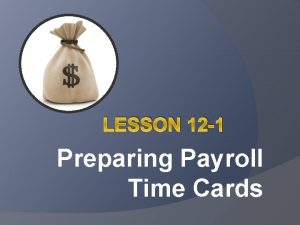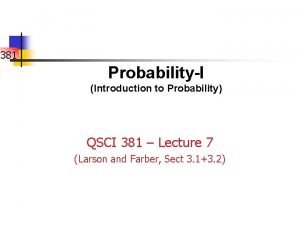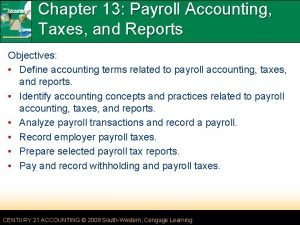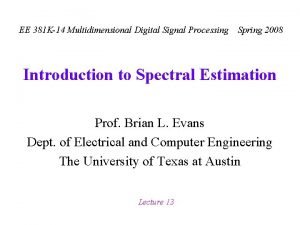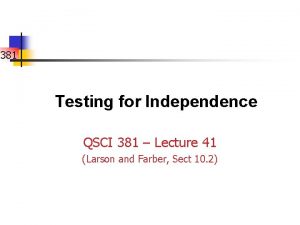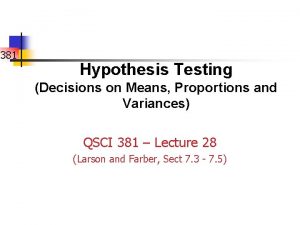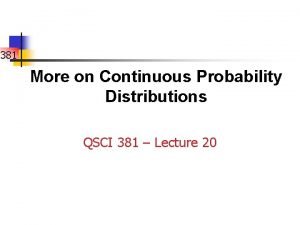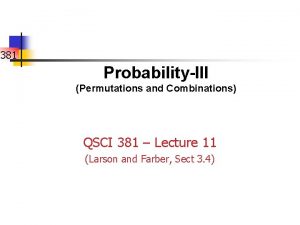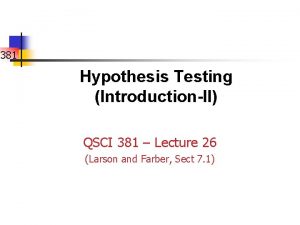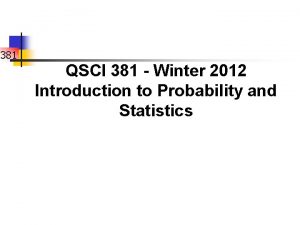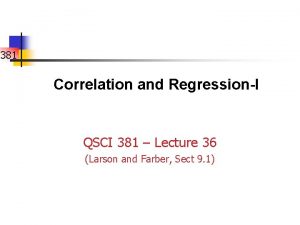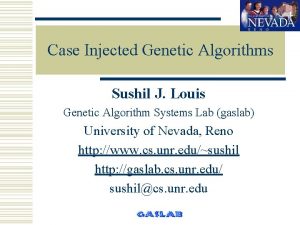Game Networking CS 381 Sushil J Louis Dept




























- Slides: 28

Game Networking CS 381 Sushil J. Louis Dept. of Computer Science and Engineering University of Nevada, Reno From and much thanks to http: //gafferongames. com/networking-for-game-programmers/udp-vs-tcp/

Internet § Internet connectivity is usually over TCP/IP sockets § TCP Sockets look like this M 1 write read write M 2 § Reading from a socket is like reading from a file § Writing to a socket is like writing to a file § So § How M 1 and M 2 are not directly connected by a wire § Messages (or packets) are routed over the internet using the Internet Protocol (IP)

TCP / IP Sockets § IP is Internet Protocol § M 1 will pass packets to the next computer (router) in the direction of M 2 § No guarantee that packet will reach M 2 § TCP is Transmission Control Protocol § Implementation is complicated! But TCP sockets include this implementation § Sets up a connection between M 1 and M 2 to make reading and writing over sockets as simple as reading / writing files § Built on top of IP to guarantee error free, complete, inorder delivery

UDP Sockets § UDP is User Datagram Protocol § Very thin layer on top of IP § Sender: § Sends packet over IP to destination address 134. 197. 30. 120 (M 2) and port 54321 § NO delivery guarantee § Receiver § Listens on port 54321 on M 2 and when a packet arrives from ANY machine, you get the address of sender, the size, and you can read the message § UDP is unreliable § 1 -5% of packets get lost usually – sometimes 100% § No ordering: M 1 sends 1, 2, 3, 4, 5. M 2 gets 3, 1, 2, 5, 4 § If you get packet, you get packet error free

TCP/IP Python Socket Code # TCP server example import socket server_socket = socket(socket. AF_INET, socket. SOCK_STREAM) server_socket. bind(("", 5000)) server_socket. listen(5) print "TCPServer Waiting for client on port 5000" while 1: client_socket, address = server_socket. accept() print "I got a connection from ", address while 1: data = raw_input ( "SEND( TYPE q or Q to Quit): " ) if (data == 'Q' or data == 'q'): client_socket. send (data) client_socket. close() break; else: client_socket. send(data) data = client_socket. recv(512) if ( data == 'q' or data == 'Q'): client_socket. close() break; else: print "RECIEVED: " , data

Code # TCP client example import socket client_socket = socket(socket. AF_INET, socket. SOCK_STREAM) client_socket. connect(("localhost", 5000)) while 1: data = client_socket. recv(512) if ( data == 'q' or data == 'Q'): client_socket. close() break; else: print "RECIEVED: " , data = raw_input ( "SEND( TYPE q or Q to Quit): " ) if (data <> 'Q' and data <> 'q'): client_socket. send(data) else: client_socket. send(data) client_socket. close() break;

UDP/IP Python Socket Code # UDP server example import socket server_socket = socket(socket. AF_INET, socket. SOCK_DGRAM) server_socket. bind(("", 5000)) print"UDPServer Waiting for client on port 5000" while 1: data, address = server_socket. recvfrom(256) print "( " , address[0], " " , address[1] , " ) said : ", data

UDP/IP Python Socket Code # UDP client example import socket client_socket = socket(socket. AF_INET, socket. SOCK_DGRAM) while 1: data = raw_input("Type something(q or Q to exit): ") if (data <> 'q' and data <> 'Q'): client_socket. sendto(data, ("localhost", 5000)) else: break client_socket. close()


Networking Games UDP vs TCP § Connection based § Guaranteed reliable and ordered § Automatically breaks up data into packets for you § Makes sure it doesn’t send data too fast for the connection to handle (flow control) § Easy § Like Reading/Writing from/to a file § No concept of connection – you have to code this § No guarantee of reliability or ordering of packets. Duplicate and Lost packets possible § You have to packetize § You have to handle flow control § If packet loss, you have to detect and get the packet resent or otherwise handle it We should obviosly use TCP over IP right?

Real-time networked games use UDP! § Games need latest data, fast – old game state is useless § TCP packetizes and queues up small packets to send § Queuing can cause delays § TCP_NODELAY option gets rid of this problem § TCP reliability implementation cause delays § What happens when a packet is lost? § What happens when a packet arrives out of order? § Detect loss and ask for sender to resend lost packet § Even if newer data arrives, M 2 has to wait till old data packet gets resent § If the old data packet also gets lost? . . Very bad.

TCP bad – UDP good § M 1 sends data packets [d 1, d 2, d 3, d 4, …. ] to M 2 § M 2 acknowledges each packet sent by sending an ack packet to M 1 [a 1, a 2, a 3, a 4] § Now suppose a data packet, d 2, gets lost, § § § Assume 70 ms to get from M 1 to M 2 M 1 send d 2, waits for 140 ms to get a 2 from M 2 d 2 got lost! M 1 sends d 2 again 140 ms after it first sent it and it takes 70 ms to M 2 to get d 2 M 2 gets d 2 210 ms after it was first sent in the BEST case Suppose d 2 again gets lost, ½ second delays possible! § RT games cannot deal with this kind of delay – think flying bullets § What happened a second ago does not matter § So games use UDP – check out Open. Ecslent’s Network Manager and Network Aspect.

http: //gafferongames. com/networking-forgame-programmers/udp-vs-tcp/ § Consider a very simple example of a multiplayer game, some sort of action game like a shooter. You want to network this in a very simple way. Every frame you send the input from the client to the server (eg. keypresses, mouse input controller input), and each frame the server processes the input from each player, updates the simulation, then sends the current position of game objects back to the client for rendering. § So in our simple multiplayer game, whenever a packet is lost, everything has to stop and wait for that packet to be resent. On the client game objects stop receiving updates so they appear to be standing still, and on the server input stops getting through from the client, so the players cannot move or shoot. When the resent packet finally arrives, you receive this stale, out of date information that you don’t even care about! Plus, there are packets backed up in queue waiting for the resend which arrive at same time, so you have to process all of these packets in one frame. Everything is clumped up!

Use both TCP and UDP? § NO because TCP affects UDP packet loss. TCP causes UDP packet loss

Peer to Peer Lockstep § No client, no server § Fully connected mesh topology § Easiest § First developed for RTS § Turns and commands § Common initial state (starting in a game lobby) § Beginning of each TURN § Send all commands to all machines § All machines run commands § End Turn

Peer to Peer lockstep § Simple, elegant. § Non-linearity § Ensuring complete determinism is hard. Slight differences amplify with time § Latency § All commands must be received before simulating that turn. Latency = max latency over all players! § Command Conquer, Age of Empire, Starcraft § Best over LANs But…

Client/Server § Lockstep not good for action games like DOOM over internet. § Each player is now a client and they all communicate with a server. § Server ran the game simulation, dumb clients interpolated between states received from the server § All input goes from clients to server § Keypresses, mouse movement, presses § Server simulates, changes entity states § Client gets new entity states, interpolates between old and new states § Players could come and go in the middle of the game. Quality of connection depends on client server connection

Client server problems § Latency is still the big problem

Client-side prediction § Latency compensation § Interpolation § John Carmack on Quake. World § I am now allowing the client to guess at the results of the users movement until the authoritative response from the server comes through. This is a biiiig architectural change. The client now needs to know about solidity of objects, friction, gravity, etc. I am sad to see the elegant client-as-terminal setup go away, but I am practical above idealistic.

Client-side prediction §All machines are the same and run the same code no dumb clients §One machine is still the authority server §So § Client simulates the movement of your entity locally and immediately in response to your input § No latency issue. Immediate movement § How do I synchronize with all the other players? § Communicate with server and correct your movement in response to server state messages

Client-side prediction § But server state is past-state! § If it takes 200 ms for round trip message between client and server, then server correction for the player character position will be 200 ms in the past, . relative to now Client Moved 200 ms Moved 100 ms Server Move 000 100 200 300 400 500 600 700 800

Client-side prediction soln § Keep a buffer of past local state (and input) for each entity § When client gets correction from server § Discard state older than server state § Simulate from server state to now § This is your (client entity) new predicted position using latest info from server § Look at the difference in position § Between the predicted position and your current position p. Diff § Note network latency § Keep simulating forward from current position, but interpolate to eliminate p. Diff within latency amount of time § By the time you next get a correction from server, your predicted position should be your current position!

How do you network games? Open. Ecslent Networking: Commands Server Running game Server game state Commands Client Running game

How do you network games? Open. Ecslent Networking: tick Gfx Mgr Entity Mgr Thread run loops Network Sender Thread Network Mgr Network Receiver Thread Game Engine

381 engine networking § All machines run the game § Whenever either user gives a command, the network subsystem sends the command arguments to the server Server state § Server BROADCASTS game state to all clients § Time stamp dh, ds § pos, vel, orientation, § desired. Speed, desired. Heading § Client syncs game state with Server’s state C 1 dh, ds C 2 C 7

Client Sync § Network thread § Get data packet § Put in queue § Get LATEST data from queue (Game Thread) § Switch (type of data) { § Case (Game state): (this is in net. Aspect. py) § Update latency, t § For each entity, e, in data packet § § § Get pos, ori of entity, from t seconds ago Predict where server entity will be now, if it was at pos, t seconds ago (physics) Predict server entity’s orientation, if it was at ori, t seconds ago (physics) Look at the difference in current and predicted pos and ori. Using this difference Interpolate over t seconds to move entity from current pos to predicted pos Interpolate over t seconds to move entity from current ori to predicted ori

UDP packets § Max size is 65536 bytes § Open Ecslent packet design § Every packet has Packet header § Packet type: state, command, info request, …(2 bytes) § For how many ents: (say 4 bytes) § Game state packet (open. Ecslent) § Must be big enough to hold state for all entities in simulation § px, py, pz, vx, vy, vz, speed, yaw, dh, ds (10 * 4 = 40 bytes) § 65536 – 6 = 65530/40 = 1638 ents supported. Packet data

Originally designed by Michael Oberberger Open. Ecslent Protocol §Server has two threads § One thread broadcasts state every 100 ms § Second thread handles client requests § Request for info about new entity § User command that changes entity’s dh, ds §… §Client has two threads § One thread sends commands § Other thread handles server messages § If games state message type § If known entity: sync § If unknown entity: § Ask for entity info § If entity info message type: § Create entity
 Sushil louis
Sushil louis Sdn vs traditional network
Sdn vs traditional network Sushil maslekar
Sushil maslekar Bedford interview skills
Bedford interview skills Sushil khanna
Sushil khanna Pradeep dubey intel
Pradeep dubey intel Problem question sushil a salesperson
Problem question sushil a salesperson Louis vuitton history timeline
Louis vuitton history timeline Me 381
Me 381 1. 13-1 work together, p. 381
1. 13-1 work together, p. 381 Qsci 381
Qsci 381 381 meaning
381 meaning Ee 381
Ee 381 1. 13-1 work together, p. 381
1. 13-1 work together, p. 381 S 381
S 381 Ee 381
Ee 381 381 meaning
381 meaning Dönem ayirici hesaplar 180 181 280 281 380 381
Dönem ayirici hesaplar 180 181 280 281 380 381 Dönem ayırıcı hesaplar örnek
Dönem ayırıcı hesaplar örnek Test of independence
Test of independence Meaning 381
Meaning 381 Finance departments
Finance departments Dept ind onegov
Dept ind onegov Rowan county dept of social services
Rowan county dept of social services Pt dept logistik
Pt dept logistik Fire dept interview questions
Fire dept interview questions Affiliation poster
Affiliation poster Liz welch mississippi
Liz welch mississippi Rewley house continuing education library
Rewley house continuing education library









